

Heritage Inventory Outer Hawera. Papers Past. DigitalNZ. * NZine * - Preserving Treasures Of The Past - 9 - Hawera - A Town That Treasures Its Past And Is Vital Today - New Zealand Travel, Hawera, Taranaki, North Island, New Zealand, Dairy Farming, Historic Buildings, Hawera Water Tower. Preserving Treasures Of The Past - 9Hawera - A Town That Treasures Its Past And Is Vital TodayDorothy - 11/8/00 I once would have defined Hawera as the South Taranaki town you drive through where State Highway 3 turns inland to the east of Mt Taranaki/Egmont between Wanganui and New Plymouth.

That was before we visited there. This town has places well worth a visit as you find out when you allow yourself time to look around. Hawera Memorial Arch - War Memorials WWI and WWII in Taranaki - Kete New Plymouth. Topic: Hawera Memorial Arch Topic type: Princes Street, Hawera Hawera War Memorial The Hawera Memorial Arch is a large monument to the fallen of the World Wars I & II.
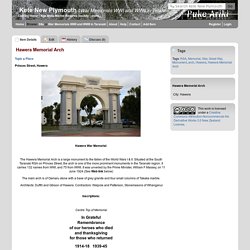
Situated at the South Taranaki RSA on Princes Street, the arch is one of the more prominent monuments in the Taranaki region. The main arch is of Oamaru stone with a base of grey granite and four small columns of Takaka marble. Architects: Duffill and Gibson of Hawera. Inscriptions: Centre Top of Memorial In GratefulRemembrance of our heroes who diedand thanksgiving for those who returned Marble panels on each side of the arch: Left Side: Those who made thesupreme sacrificeWorld War I1914-18: 104 names in 2 columns) Right Side: Those who made thesupreme sacrifice1914-1918: (28 names in 2 columns) (75 names in 2 columns ( 37 and 38)) Plaque 1, Column 1: Plaque 1 Column 2: [Total WWI 132] Plaque 2, Column 1 (Cont.): Plaque 2,Column 2 (Cont [Total WWII 75] On left hand granite base (difficult to read) This memorial was erected [& funded?]
TARANAKI REDOUBTS, 1879–81. Mr.
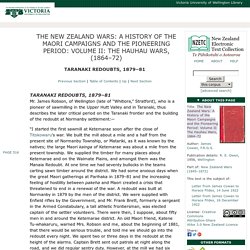
James Robson, of Wellington (late of “Whitiora,” Stratford), who is a pioneer of sawmilling in the Upper Hutt Valley and in Taranaki, thus describes the later critical period on the Taranaki frontier and the building of the redoubt at Normanby settlement:— “I started the first sawmill at Ketemarae soon after the close of Titokowaru's war. We built the mill about a mile and a half from the present site of Normanby Township, or Matariki, as it was known by the natives; the large Maori kainga of Ketemarae was about a mile from the page 516 present township. We supplied the timber for many places about Ketemarae and on the Waimate Plains, and amongst them was the Manaia Redoubt. At one time we had seventy bullocks in the teams carting sawn timber around the district. Hawera First World War memorial.
Turuturumōkai NZ Wars memorial. This memorial stands on the remains of Turuturumōkai Redoubt.
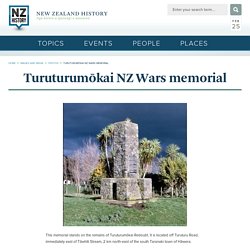
It is located off Turuturu Road, immediately east of Tāwhiti Stream, 2 km north-east of the south Taranaki town of Hāwera. The Turuturumōkai memorial records the dramatic events of 12 July 1868. On a frosty morning, a small garrison fought desperately to hold off a vastly superior Māori force. The raid was orchestrated by Ngāti Ruanui’s military leader, Riwha Tītokowaru. Tītokowaru’s strategy during his war of 1868–9 was one of controlled provocation.
Turuturumōkai was first established by the 18th (Royal Irish) Regiment in November 1866. The raid was Tītokowaru’s first attack on a military redoubt in this campaign. The garrison was taken completely by surprise. At 7 a.m. The bodies of the 10 troops killed at Turuturumōkai were buried at Waihī Cemetery. Tītokowaru’s strategy now came to fruition. Concrete Water Tower. Albion Street And High Street, Hawera List Entry Information List Entry Status Listed List Entry Type Historic Place Category 1 List Number 143 Date Entered 21st September 1989 Locationopen/close City/District Council South Taranaki District Region Taranaki Region Legal description Lot 1 DP 21 Lots 25-30 of sec 19 Town of Hawera Summaryopen/close Completed in 1914, the Concrete Water Tower in Hawera was the largest, reinforced concrete tower then constructed in New Zealand.
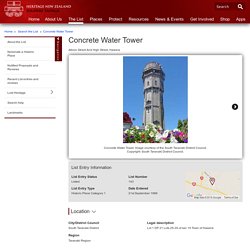
The small town of Hawera, which means 'burnt place' in te reo Maori, was built on a plain confiscated from Ngati Ruanui by the Crown in the 1860s. One option was the water tower, a favoured means of increasing water pressure in towns built on flat land. Cameron incorporated two separate tanks into the new water tower's design. The tower proved to be a major attraction for visitors to Hawera and became a symbol for the town's identity. As Hawera's population increased, the demand for water grew. Assessment criteriaopen/close A. IPENZ Engineering Heritage. Category Engineering Work (eg road, bridge, sawmill, dam) Description This reinforced concrete water tower was completed in early 1914 to provide adequate water pressure for fire fighting.
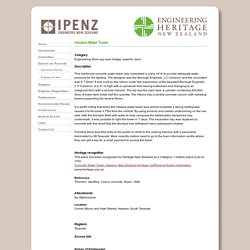
The designer was the Borough Engineer, J C Cameron and the consultant was S T Silver. It was built by day labour under the supervision of the Assistant Borough Engineer, C P Cameron. Waverley Heritage Inventory. Kaponga Heritage Inventory. Eltham Heritage Inventory. Opunake Heritage Inventory. Manaia Heritage Inventory. Hawera Heritage Inventory. Patea Heritage Inventory.